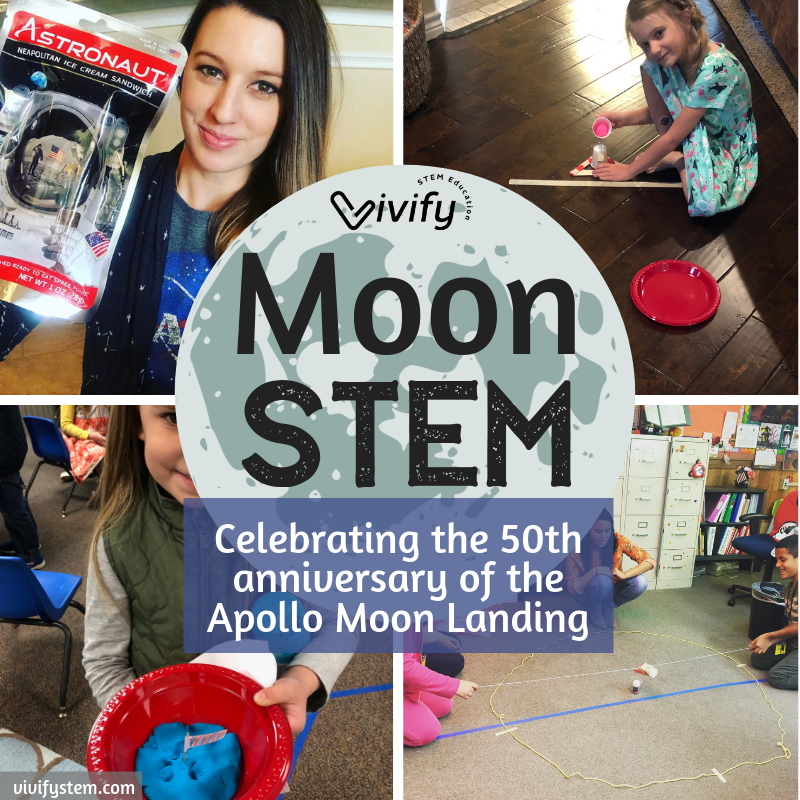DIY Moon Dust STEM
DIY Moon Dust STEM
It has been almost 50 years since the last human set foot on the Moon. Have you ever wondered what that dusty surface is like? Now you can learn about it and play with Moon dust that you can make right in your kitchen. Read on to learn how!
In all, there were six Apollo missions that successfully landed astronauts on the Moon. One major complication to all six missions was the pervasive lunar dust. It stuck to everything! The astronauts that walked the surface of the Moon returned to the lander with their suits covered in dust that then ended up all over their equipment and even in their noses, eyes, and throats. Looking at the grains of dust under a microscope revealed jagged edges that made the particles easily stick to anything that agitated it. The lunar dust is reported to have a smell like gunpowder and a texture like powdered glass. You can bet that engineers are currently working on a way to prevent the dust from harming equipment and the astronauts in future missions to the Moon!
** This post contains affiliate links
Make your own Moon Dust (Moon Sand or Kinetic Sand) with this easy recipe, then add some STEM activities!
Experiment with Moon dust by making your own at home. The DIY Moon dust is similar to Moon Sand or Kinetic Sand but way cheaper and so easy to make.
Here is what you need:
8 cups of all-purpose flour
1 cup of oil (baby oil or canola oil for edible sand)
Glitter (optional)
Next, simply mix your flour and oil really well in a large bowl. Using a potato masher works really well for this. Once your mixture is smooth, you may add in some glitter (because who doesn’t love glitter ;) ).
That’s it! Now it’s time to play and experiment with your Moon dust. Here is what we suggest:
Build a rover out of recyclable materials or out of LEGOs or other construction sets. Then drive over your lunar terrain. How well do you think your wheels’ tracks will hold up over time. Did you know that the tracks from the lunar roving vehicle (LRV) used in the Apollo missions are still on the Moon almost 50 years later? The Moon has no atmosphere-- no wind or weather to errode the tracks.
Can you build a tower out of the Moon dust that will support your rover? How about a ramp that provides enough potential energy for it to roll down to the bottom. With gravity on the Moon 1/6th that of Earth, a lunar rover would move slower down the ramp on the Moon than it would on Earth.
Make Moon craters. Drop small balls of different sizes and densities to make craters on your lunar surface. What happens to the Moon dust around the crater? Learn more about craters and the space rocks that form the with this engaging Crater STEM Engineering and Science lesson that involves catapults too.
Check out our huge list of more activities and resources about the Moon and ways you can join in celebrating NASA’s 50th anniversary of the Apollo Moon landing in our blog post here.
The last man on the Moon was Eugene Cernan in 1972. He along with Harrison H. Schmitt, the first scientist to go to the Moon, took three rover excursions covering 21 miles to craters, rock slides, and mountain walls. In 22 hours of moonwalks, they collected 250 pounds of rocks and soil that they brought back to Earth that we are still studying today. The astronauts collected bluish-gray and tan rocks estimated to be four billion years old, drilled heat-probe holes, and journeyed to a 7,000-foot tall mountain called the South Massif. At the edge of a deep crater they found a fumarole, an ancient vent for volcanic gases, where they collected strange orange and red soil samples.
Astronaut Cernan also etched his daughter’s initials — TDC, for Teresa Dawn Cernan — in the lunar dust which is likely to remain until the end of time. Think of the enduring mark you may leave on your kids by exposing them to the endless possibilities of STEM. The Apollo program is proof that STEM makes dreams become reality.
**Vivify is a participant in the Amazon Services LLC Associates Program, an affiliate advertising program designed to provide a means for us to earn fees by linking to Amazon.com and affiliated sites. This post contains affiliate links.



